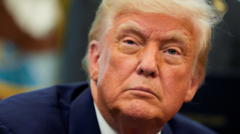On April 28, 2025, Canadians headed to the polls in a critical election poised to determine the country's next leader amid escalating economic challenges and strained ties with the U.S. President Trump’s administration has intensified its trade war with Canada, complicating the electoral backdrop for both the Liberal Party’s Mark Carney and the Conservative Party’s Pierre Poilievre. Polling data indicates a neck-and-neck race, with the once-dominant Conservatives now facing a resurgence from the Liberals following leadership changes and spiraling economic issues.
Canada's Pivotal Election: Mark Carney Faces Off Against Pierre Poilievre Amid Economic Turmoil

Canada's Pivotal Election: Mark Carney Faces Off Against Pierre Poilievre Amid Economic Turmoil
Canadians are casting their votes amid high stakes that may redefine the country's leadership and its relationship with the U.S.
Pre-election polling revealed a close contest with Carney, the recently appointed prime minister and former central banker, showing a slight lead over Poilievre, who has faced scrutiny for his parallels to Trump and controversial policies. The incumbent’s ascension from Justin Trudeau’s shadow to prime minister just weeks prior has spotlighted his experience in economic governance, particularly as voters express growing concern over housing affordability and living costs across the country.
Only months ago, the Conservatives enjoyed a remarkable lead, driven primarily by discontent with Trudeau's administration. However, the landscape shifted dramatically following both Trudeau’s resignation and Trump’s combative rhetoric toward Canada, prompting many voters to pivot back to the Liberals as a stabilizing force capable of managing international relations and protecting the economy.
Voters will decide among larger party options—the Liberals, Conservatives, and smaller parties such as the New Democrats, aimed at maintaining their parliamentary representation despite dwindling support. The implications of this election extend beyond party lines, as it poses fundamental questions about Canada’s identity amid external threats to its sovereignty.
Canada’s electoral system mandates that citizens vote for local candidates within their districts, contributing to the overall composition of the 343-seat House of Commons, where a plurality of seats usually translates to power. Polls across Canada opened on April 28, with closing times staggered across the country’s time zones to facilitate smooth voting processes.
As economic forecasts anticipate further fallout from Trump’s tariffs, both candidates are vying to implement tax reforms targeting housing affordability to address the pressing concerns of millions of Canadians who are increasingly frustrated by ballooning living costs. The stakes couldn't be higher, as economic forecasts suggest a potential recession looming over Canada if relations with the United States do not stabilize.
Political analysts predict that the outcome of this election may reshape not only domestic policies but also the bilateral dynamics between Canada and the United States, thrusting both Carney and Poilievre into the forefront of conversations about national identity, economic resilience, and strategic diplomacy in the face of external threats.
With millions casting their votes, the political landscape remains uncertain, but the demands for immediate action to tackle housing issues and economic disparities echo across the electoral stage, setting the tone for the next chapter in Canadian politics.
Only months ago, the Conservatives enjoyed a remarkable lead, driven primarily by discontent with Trudeau's administration. However, the landscape shifted dramatically following both Trudeau’s resignation and Trump’s combative rhetoric toward Canada, prompting many voters to pivot back to the Liberals as a stabilizing force capable of managing international relations and protecting the economy.
Voters will decide among larger party options—the Liberals, Conservatives, and smaller parties such as the New Democrats, aimed at maintaining their parliamentary representation despite dwindling support. The implications of this election extend beyond party lines, as it poses fundamental questions about Canada’s identity amid external threats to its sovereignty.
Canada’s electoral system mandates that citizens vote for local candidates within their districts, contributing to the overall composition of the 343-seat House of Commons, where a plurality of seats usually translates to power. Polls across Canada opened on April 28, with closing times staggered across the country’s time zones to facilitate smooth voting processes.
As economic forecasts anticipate further fallout from Trump’s tariffs, both candidates are vying to implement tax reforms targeting housing affordability to address the pressing concerns of millions of Canadians who are increasingly frustrated by ballooning living costs. The stakes couldn't be higher, as economic forecasts suggest a potential recession looming over Canada if relations with the United States do not stabilize.
Political analysts predict that the outcome of this election may reshape not only domestic policies but also the bilateral dynamics between Canada and the United States, thrusting both Carney and Poilievre into the forefront of conversations about national identity, economic resilience, and strategic diplomacy in the face of external threats.
With millions casting their votes, the political landscape remains uncertain, but the demands for immediate action to tackle housing issues and economic disparities echo across the electoral stage, setting the tone for the next chapter in Canadian politics.




















